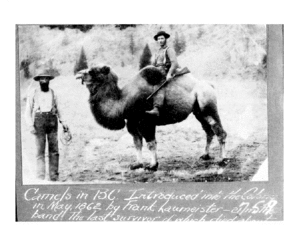Cariboo camels facts for kids
The Cariboo camels were a group of camels brought to British Columbia, Canada, to carry supplies. These Bactrian camels were used on the Douglas Road and the Old Cariboo Road in 1862 and 1863. Their job was to haul heavy goods during the exciting time of the Cariboo Gold Rush. Even though using camels didn't work out as planned, they became famous in local stories and history.
Contents
Why Camels Came to Cariboo
In 1862, a merchant named Otto Esche from San Francisco decided to sell camels in British Columbia. He might have gotten the idea from the United States Army which had used camels to carry things. These specific Bactrian camels had already worked in Arizona for building railroads and in California during their own gold rush.
On March 1, 1862, an advertisement for these camels appeared in a newspaper called the Victoria Colonist. The newspaper even joked about it, saying "The Camels are Coming!" and suggesting that whales might be next!
Soon after, a man from Lillooet named John Calbreath bought 23 camels. He paid $300 for each one. Calbreath and his business partners, Frank Laumeister, Adam Heffley, and Henry Ingram, planned to use the camels. Their goal was to transport goods from Lillooet to Alexandria on the Old Cariboo Road. Frank Laumeister became the person most connected with the Cariboo camels.
Camels Arrive in British Columbia
The camels reached Victoria on April 15, 1862, by steamship. They stayed in the city until May 4, drawing a lot of attention and appearing in many newspaper stories. While they were there, one baby camel was born. Another camel and its mother escaped into the wild on Vancouver Island and were seen again later that year.
The other camels were put on a barge and pulled by a boat to New Westminster. From there, they went to Port Douglas. By mid-May, they were already working on the Douglas Road. By May 24, they were on their way to Lillooet, getting closer to the gold fields where they were needed most.
At first, the camels seemed to be doing well. They could carry a lot of weight, about 500 to 600 pounds. This was twice as much as mules could carry! They were also good at finding their own food. However, the rough and rocky Cariboo Road was hard on their soft feet. People had to make special canvas boots for the camels to protect their feet.
By the end of June, the first group of camels had left Lillooet for Alexandria. Sadly, one camel died when it fell off a cliff into Pavilion Creek. More problems soon came from the Cariboo. Stagecoach drivers and miners complained a lot. Horses pulling stagecoaches were terrified of the camels and would often run away when they saw them. Also, the camels would sometimes eat strange things, like pants, shirts, hats, and even bars of soap!
One story tells how Judge Matthew Baillie Begbie's horse got scared by the camels. His horse ran off into the wilderness with the judge holding on tightly. Judge Begbie disliked camels for the rest of his life. By October, newspapers reported that about a dozen camels had survived their first season. They spent the winter at Quesnel Forks.
The End of the Camel Experiment
In May 1863, the camels were back in Lillooet. But after causing more problems and threats from angry stagecoach drivers, Frank Laumeister decided to stop using the camel train for good. What happened to the remaining camels has been a topic of many interesting and sometimes unbelievable stories.
Some camels were taken in by ranches as pets or for light work. One camel was even mistaken for a grizzly bear and shot by a miner named John Morris. He became known as "Grizzly" Morris. The camel wasn't wasted; it was served as a special dinner called "Grizzly's Bear" at a hotel near Beaver Lake. For many years, people reported seeing camels all over the Cariboo and Central British Columbia, but these sightings were never confirmed.
The Last Known Cariboo Camel
The last famous surviving camel was called "The Lady." She lived at a ranch in Grand Prairie, British Columbia, which is now known as Westwold. She died sometime between 1896 and 1905. "The Lady" is special because she is in the only known photograph of the Cariboo camels, shown at the top of this article. She is pictured with a man named W.H. Smith.
Places Named After the Cariboo Camels
- Camelsfoot Range
- Bridge of the 23 Camels in Lillooet


